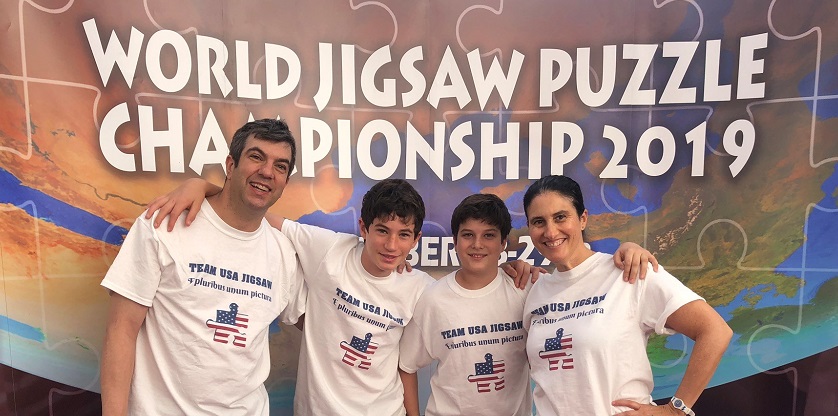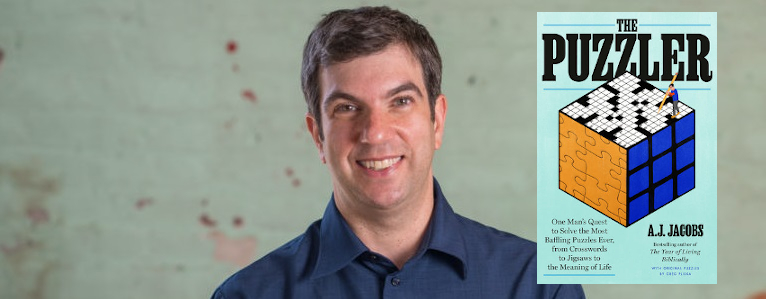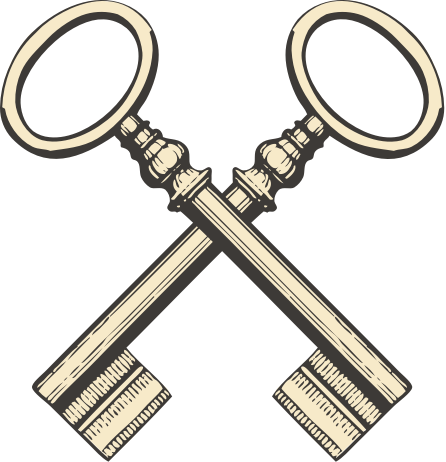Team Building Games and Puzzles Boost Problem-Solving Skills

“Monkeys used to be my favorite animal,” said Julie Jacobs, president of Watson Adventures. “Don’t make me hate you, monkeys!”
No, this wasn’t at a staff meeting. Or that time we staged one of our team-building scavenger hunts at a zoo. Actually, Julie was a member of the only team representing the U.S.A. at an international tournament for jigsaw puzzle builders.
That team consisted of Julie, two of her sons, and her husband, best-selling author A.J. Jacobs. He had drafted the family for the jigsaw battle in Spain. They had to assemble four massive puzzles in eight hours, and one featured, yes, monkeys.
How’d Team Jacobs do? To find out, you’ll have to read A.J.’s latest book, The Puzzler: One Man’s Quest to Solve the Most Baffling Puzzles Ever, from Crosswords to Jigsaws to the Meaning of Life.
We could issue a spoiler alert and skip to the part where the meaning of life is revealed… but this is a blog about scavenger hunts, so instead let’s talk about what the book reveals about strategies and techniques for winning any game—as well as the benefits of team building.
Since 1999 Watson Adventures has espoused that the collaborative problem-solving on team building games, such as our scavenger hunts, helps you flex mental muscles, and maybe discover new ones, that can sharpen your skills at cracking problems back at the office.
Early in his book, A.J. lays out three of his “favorite strategies for any kind of problems solving.” We’ll supplement his three rules with three more, teased out of his book. Drum roll please…

Rule 1: Find the toehold.
With a crossword puzzle, you start by scanning the questions to spot the low-hanging fruit. Perhaps there’s a question with a blank that’s easy to fill. A.J. cites a remark by Bill Clinton in the documentary Wordplay: “Start with what you know the answer to. And you just build on it. And eventually you can unravel the whole puzzle.”
Here’s an example of the toehold rule in action: In The Puzzler, A.J. devotes a chapter to his quest to create a new scavenger hunt for Watson Adventures. The resulting game, Puzzled to Death: A Virtual Game of Murder Mystery Puzzles, has been a big hit with corporate groups.
One round is called “Doodlepalooza”: players must pair up drawings in two columns to create phrases. At first, your eyes fly around looking for the toehold, as you make out doodles of paws, an arrow pointing to a hand, boats with arrows pointing to the sails…ah ha! You have a toehold: You also noticed in the second column a drawing of pushpins—or tacks! Sails tacks…sales tax!
As A.J. states elsewhere in the book, “The lesson is: Break the problem down. Miniaturize it. Tackle parts instead of the whole.”
Teams that deploy this strategy do well on our scavenger hunts. They are not collecting objects, but answering tricky, puzzly questions about what they find in a museum or historic neighborhood.
On our scavenger hunts at the Metropolitan Museum of Art, in the American Wing courtyard, a question asks: “What’s the unforgettable name of the person with a rear-view mirror?” Well, an obvious toehold is that you are looking for a person—that rules out a lot of sculptures in the room, such as the one of three bears. Now, where is there a “mirror”?
If you want to give it a try, here’s the art in that gallery.
But keep in mind that it’s a lot easier when you are in the museum—when you have a team of up to five other brains.
Maybe you’re not finding anything that’s shiny and reflective like a mirror. Let’s try Rule 2…
Rule 2: Embrace the eraser.
A wise person once said, “If I had my life to live over again, next time I’d make more mistakes.” Mistakes lead to discovery. And the mental eraser lets you start again.
“The Way of the Eraser is about being okay with mistakes, okay with tentative beliefs, okay with flexibility,” A.J. writes. “Keep your mind flexible. Keep it open to new perspectives. Don’t fall in love with your hypothesis.”
In The Puzzler, A.J. discovers this lesson in a variety of encounters with puzzles. In one chapter, he finds himself lost in the Great Vermont Corn Maze. (Not surprisingly, his family didn’t tag along for this quest.) Typically it takes at least three hours to complete, or up to six if you’re both unlucky and stubborn.
Over the course of four hours, A.J. embraces the mental eraser again and again, trying various strategies. Those who don’t embrace the eraser succumb to “the folly of inflexible thinking.” Maze owner Mike Boudreau tells A.J., “Some people learn from their mistakes. Other people—especially young men—you just watch them and are like, ‘Why do you keep returning to that wall? You can’t go through the wall!’ They just won’t let go of it because they think they are right.”
Back in the American Wing courtyard, you and your team might have realized that you aren’t looking for a literal mirror. But it’s an object that someone is holding. Wait, isn’t that nude, seated woman holding something round that she is staring at? Could that be a mirror…showing her a view to the rear? Ah ha! And her name is…the answer!
Did A.J. make it out of the maze on his own? You’ll have to read the book.
Rule 3: No multitasking. (But do take a break.)
The more focus you give to a puzzle, the more it rewards you. A team-building game helps sharpen your attention and your teamwork through the magic of a deadline—in the case of our scavenger hunts, a timer counting down to zero. Obviously, when it’s time to focus on the problem, it won’t help the team if you are checking your email or thumbing through TikTok.
Multitasking can just be a way to achieve mediocrity in several tasks at once.
Now, does every team remain completely focused on the task at hand for 90 minutes? We hope not! There’s plenty of time along the way for jokes and anecdotes and the stuff that bonds teams and ultimately makes them more effective. As our hunt hosts like to say when announcing the results, the low-scoring teams had the most fun. It’s OK to enjoy the scenery along the way.
Turning away from a puzzle or problem can be valuable. “When stuck, take a break,” A.J. advises. “Let the problem marinate in the back corner of your brain. Loosen your grip.”
Now we’ll add three rules to A.J.’s, which we extrapolated from his book…
Rule 4: Divide and conquer.
“One key to success,” observes A.J., “is division of labor.” At the jigsaw puzzle tournament, he discovers that this is the secret of the Russian team: “One of them specializes in sorting the colors. Another specializes in the edges. Yet another is master of the monochromatic sections—the skies, the oceans—and solves them by shape.”
On our scavenger hunts, successful teams assign roles. The team captain will use our app-based browser to direct the team and enter the answers. A person who is good at navigating will keep an eye on the museum floor plan or, on outdoor hunts, use a navigation app. Someone who is good at detail will scrutinize the wording of the questions. Someone who is good at seeing the big picture (perhaps literally) will scan the locations to make sure nothing is overlooked.
Rule 5: Beware of Joe Bloggs.
Perhaps you’ve encountered Joe in an SAT prep course: he’s the test-taker who falls for the too simple, too quick answer, overlooking the nuance that makes that answer wrong.
“The easy straight path is rarely the correct one,” A.J. notes of the corn maze. “Don’t always be looking for a shortcut. Realize that sometimes, as with solving a Rubik’s Cube, you have to retreat further away from your goal before you get on the correct path.
There’s a trap for Joe Bloggs on our Metropolitan Museum scavenger hunt. Directions guide players into the central room in the Arms & Armor galleries, and see in the center four life-size knights in armor, mounted on horses.
Our app then poses a seemingly simple question: “How many mounted horsemen are in the Arms & Armor galleries?” A dumbfounding number of teams embrace the Joe Bloggs answer: four. Look, they are right there! Done and done! But they miss the detail that we’re asking about the galleries, plural. In an adjacent gallery you can find Japanese warriors also mounted on horses. Cue the sad trombone…
6. Don’t forget to have fun.
It’s just a game, just a puzzle. Have a laugh. Puzzles have a lot in common with jokes. We’ve long said that a good scavenger hunt question is like a good joke: it’s a controlled release of information, leading to a sudden insight that produces a guffaw or an “ah ha!”
A longtime writer for The Simpsons, Mike Reiss, shares this belief. “So many of my favorite jokes are actually puzzles, and more precisely algebra problems: you have to solve for the missing element x, where x = the comedy,” Reiss tells A.J. “For instance, ‘The towels in this hotel are so fluffy, I can barely close my luggage.’ The joke is he’s stealing towels, something never mentioned anywhere in the joke.”
As a humorist, A.J. has filled The Puzzler with funny stories and amusing observations. On one page he’ll cite, as an example, a great Steven Wright one-liner (“All those who believe in psychokinesis, raise my hand”). On another, he’ll make this quirky, delightful observation: “Has there ever been a more brilliantly designed punctuation than the question mark and the exclamation point? The question mark is all twists and turns and mystery. The exclamation point—so assertive and aggressive and final!)”
And as if to prove his point, later in the book he sums up the world of puzzles—and team-building scavenger hunts, with this quote:
“As Maki Kaji—the late godfather of Sudoku—said, puzzles are a journey: ? → !”
And finally, we have it on good authority that Julie still likes monkeys.
